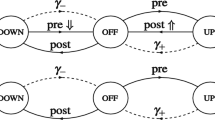Abstract
The statistical dynamics of an impulse induced quanta turnover is studied by means of a nonstationary stochastic model — double barrier synapse — resulting from a previously developed mathematical theory of chemical synaptic transmission. An essential aspect of nonstationarities of the model is that the interpool quanta transfers follow binomial distribution at impulse arrival time, while in the absence of stimulation they obey Yule-Furry statistics.
Under a variety of conditions, corresponding to those in actual experiments, the transient behaviour of the model is simulated and analysed in detail. As a result, the quantitative description of immediate and delayed components of synaptic action is introduced. If simulations of quantal fluctuations are performed numerically, then for the treatment of dynamic regularities, besides numerical procedures, an analytical method of envelopes is developed. It is supported, by the theorems which reduce behaviour of the double-barrier synapse to the super-position of simpler solutions for single-barrier systems.
With short-term facilitation quantitative analysis and simulations, the synaptic resonance phenomenon is theoretically predicted: different resonant frequencies are found at different levels of facilitation. The importance of this phenomenon treated as a clue to the information processing capabilities of a chemical synapse is discussed.
Similar content being viewed by others
References
Bharucha-Reid AT (1960) Elements of the theory of Markov processes and their applications. McGraw Hill Book Co, New York
Byne W (1988) On the mechanism of quantal acetylcholine release. Einstein Q J Biol Med 6:158–166
Capek R, Esplin B (1977) Homosynaptic depression and transmitter turnover in spinal monosynaptic pathway. J Neurophysiol 40:95–105
Del Castillo J, Katz B (1954) Statistical factors involved in neuromuscular facilitation and depression. J Physiol 124:574–585
Del Castillo J, Katz B (1955) Local activity at a depolarized nerve-muscle junction. J Physiol 128:396–411
Eccles JC (1964) The physiology of synapses. Springer, Berlin Heidelberg New York
Hubbard JI (1963) Repetitive stimulation at the mammalian neuromuscular function and the mobilization of transmitter. J Physiol 169:641–662
Kreibel ME, Vautrin J, Holsapple J (1990) Transmitter release: prepackaging and random mechanism or dynamic and deterministic process. Brain Res Rev 15:167–178
Matis JH, Wehrly TE (1979) Stochastic models of compartmental systems. Biometrics 35:199–220
Melkonian DS (1990) Mathematical theory of chemical synaptic transmission. Biol Cybern 62:539–548
Melkonian DS (1991) Double barrier quantal model of neurotransmitter release. Neuroreport 2:719–722
Melkonian DS, Sarkissian SG (1989) Informational transformations in neuronal networks with dynamic synaptic elements. Biol J Armenia 42:393–400 (in Russian)
Miyamoto MD (1986) Probability of quantal transmitter release from nerve terminals: theoretical considerations in the determination of spatial variation. J Theor Biol 123:289–304
Redman S (1990) Quantal analysis of synaptic potentials in neurons of the central nervous system. Physiol Rev 70:165–198
Tauc L (1982) Nonvesicular release of neurotransmitter. Physiol Rev 62:857–893
Thesleff S (1986) Different kinds of acetylcholine release from the motor nerve. Int Rev Neurobiol 28:59–88
Zucker RS (1973) Changes in the statistics of transmitter release during facilitation. J Physiol 229:787–810
Author information
Authors and Affiliations
Rights and permissions
About this article
Cite this article
Melkonian, D.S. Transient analysis of a chemical synaptic transmission. Biol. Cybern. 68, 341–350 (1993). https://doi.org/10.1007/BF00201859
Received:
Accepted:
Issue Date:
DOI: https://doi.org/10.1007/BF00201859




